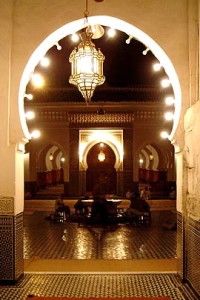njoying the ambiance in various Moroccan cities is partly what a trip to Morocco is all about. When traveling to Morocco, make sure to take time out to enjoy Moroccan coffee and the cafe ambiance that each city offers. Marrakech, Tangier, Essaouira and Agadir are known for having the most and the best cafe’s, the best variety of Moroccan Arabic coffee and are spacious, comfortable hotspots for people watching. Moroccan coffee is different from American coffee. The two most commonly-ordered types are black, served in a Moroccan teaglass, and coffee with milk, usually served in a cup, but sometimes in a tea glass.There are several types of coffee with milk. The first is café cassé, which means black coffee broken with a little bit of milk. The other common type is “café nss nss” (no vowel in nss), which means half coffee (made with water) and half milk.







